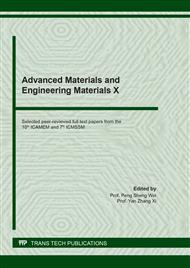[1]
A.K. Behera, R.A. Sousa, G. Ingarao, V. Oleksik, Single point incremental forming: An assessment of the progress and technology trends from 2005 to 2015, Mater. Manuf. Process. 27 (2017) 37-62.
DOI: 10.1016/j.jmapro.2017.03.014
Google Scholar
[2]
Y.L. Li, X.X. Chen, Z.B. Liu, J. Sun, F.Y. Li, J.F. Li, G.Q. Zhao, A review on the recent development of incremental sheet-forming process, Int. J. Adv. Manuf tech. 92 (2017) 2439-2462.
DOI: 10.1007/s00170-017-0251-z
Google Scholar
[3]
M. Dwivedy, V. Kalluri, The effect of process parameters on forming forces in single point incremental forming, Procedia. Manufacturing. 29 (2019) 120-128.
DOI: 10.1016/j.promfg.2019.02.116
Google Scholar
[4]
H. Zhu, D.X. Xiao, J. Kang, Research on the double sided incremental forming toolpath planning and generation based on STL model, Int. J. Adv. Manuf. tech. 102 (2019) 839-856.
DOI: 10.1007/s00170-018-03221-9
Google Scholar
[5]
V. Gulati, A. Aryal, P. Katyal, A. Goswami, Process parameters optimization in single point incremental forming, J. Inst. Eng. (India): Ser. C. 97 (2016) 185-193.
DOI: 10.1007/s40032-015-0203-z
Google Scholar
[6]
G. Hussain, H.R. Khan, L.G.N. Hayat, Guidelines for tool-size selection for single-point incremental forming of an aerospace alloy, Mater. Manuf. Process. 28 (2013) 324-329.
DOI: 10.1080/10426914.2012.700151
Google Scholar
[7]
M. Strano, Technological representation of forming limits for negative incremental forming of thin aluminum sheets, J. Manuf. Process. 7 (2005) 122-129.
DOI: 10.1016/s1526-6125(05)70089-x
Google Scholar
[8]
L.T. Gao, Y.X. Zhao, Z. Yu, H. Yan. Formability analysis of electrically assisted double-side multi-point incremental sheet forming, Int. J. Adv. Manuf. Tech. 108 (2020) 3405-3417.
DOI: 10.1007/s00170-020-05576-4
Google Scholar
[9]
R. Lingam, A. Srivastava, Deflection compensations for tool path to enhance accuracy during double-sided incremental Forming, J. Eng. Ind. 138 (2016) 1-11.
DOI: 10.1115/msec2015-9404
Google Scholar
[10]
M. Deng, A. Ghiotti, S. Bruschi, K. F.Ehmann, J. Cao, On the fracture characterization in double-sided incremental forming of Ti6Al4V sheets at elevated temperatures, Procedia Manufacturing. 10 (2017) 407-416.
DOI: 10.1016/j.promfg.2017.07.014
Google Scholar
[11]
R. Malhotra, J. Cao, M. Beltran, D.K. Xu, J. Magargee, V. Kiridena, Z.C. Xia, Accumulative-DSIF strategy for enhancing process capabilities in incremental forming, Cirp Ann-Manuf teche. 61 (2012) 251-254.
DOI: 10.1016/j.cirp.2012.03.093
Google Scholar


